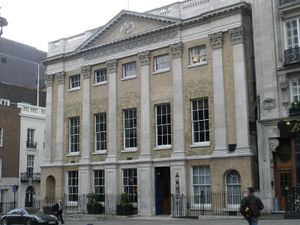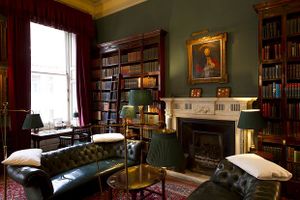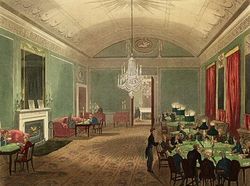Brooks's

Brooks's (which is the correct spelling and punctuation!) is an exclusive gentlemen's club in London and is located at 60 St James' Street. Brooks's is liberal, with a largely Whiggish membership. Those with a Tory bent frequent White's at 43 St James' Street.
To become a member, a man must be proposed by a current member, with a system of black and white balls used to vote on the prospective man's membership. A single black ball is enough to exclude him from becoming a member, giving rise to the term 'blackballed'. This system is not exclusive to Brooks's, being used in other clubs.
If White's was considered the most aristocratic of the clubs, Brooks's was the most interesting. Slightly less fashionable than White's, but joined by Brummell nonetheless, was Brooks's. This was and is just down the street from White's, slightly nearer St. James's Palace. The subscription to Brooks's in 11 guineas per annum.
Brooks's was arguably the most elegant of the London clubs in architectural terms. Henry Holland, son-in-law of Capability Brown and architect to the Prince of Wales, had created in the Great Subscription Room one of the finest interiors in London. Restrained, neoclassical, the style of Brooks's was the style its members exported to their country seats and civic buildings all over Britain and beyond. The walls in Brummell's day were greenish gray and the curtains red damask. There were painted allegories over the doors, appropriately of Bacchus, Venus and Cupid, and one of the largest barrel vaults in the capital, festooned with gilt swags, crowned the famous Subscription Room. The effect, however, was cool and patrician. At Brooks's, internally the rooms were arranged around a central double-height space housing the staircase. As well as providing each room with access from a public hallway, this layout also gave all rooms equal status, creating a rather different social space to the sequential and intimate arrangement of Boodle's where one room had to be entered to reach another.
The gambling room or the 'sanctum sanctorium', known as the saloon in Boodle's and the subscription room in Brooks's was the place where the anxiety of debt repayment and the ambitions of instant profit were focused. In the 18th century, White's was the place for gambling but as club rules restricted certain kinds of games, Brooks's replaced White's as the club 'notorious for high play'. By 1800 Brooks's had entered its years as a gambling den, where family fortunes accumulated over generations were lost on the roll of a die or turn of a card. Brooks's was open, in effect, 24 hours a day. Over the years a night at Brooks's ended for many with a trip to a usurer or moneylender - often in the City - to secure a loan to pay the gambling debts accrued in the club. When Brummell joined, the club (Brooks's) was populated by a slightly more raucous though older, crowd than White's. The tone at Brooks's, therefore, changed somewhat between day and night, as the older men, generally, left the club to the gambling and drinking of a younger, more aristocratic crowd, unencumbered by families, scruples or political careers.

Members
(Note: Names in italics are former characters or NPCs) See also Club Membership
- Captain Arthur Cartwright, Royal Marines
- Benedict Delancey
- Patrick Grove
- Rawdon Montgomery III, Marquess of Eastborough
- Rawdon Montgomery IV, Earl of Alderhan
- Lord Ivor Montgomery
- Blake Pritchard, Marquess of Emerson
- Lord Gabriel Pritchard
- Richard Fitzgerald I, Earl of Rotherham [1]
- Richard Fitzgerald II, Viscount Surrey
- Lieutenant-Colonel Robert Fitzgerald
- Commander Nathaniel Scarborough
- Mr Adrian Carey
<references>
- ↑ Lord Rotherham is of the Whig persuasion and his membership of Brooks's may be assumed from the thread Hearts on a Tightrope
